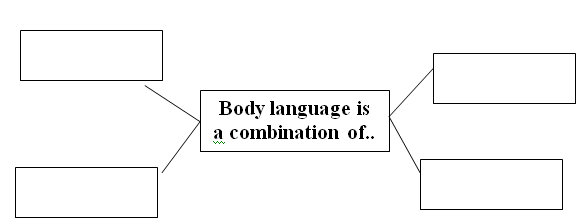

Non-Textual Passage
SECTION IV
Non-Textual Passage- 15 marks
Q.4. (A) Read the following passage and do the activities :(10 marks)
A1. Fill in the blanks: (2)
(i)……….percent of our daily communication is non-verbal
(ii) Eye contact is another type of………. Communication.
(i) Frequent blinking is a sign of the person feeling…………….
(iv) One can readily detect………….
|
According to some experts, a staggering 93 percent of our daily communication is non-verbal. Facial expressions are easy to decipher. One can readily detect happiness, sadness, anger. Physicians can tell a patient is doing well (or not) by looking at his/her face. Eye contact is another type of non-verbal communication, which can tell a lot about the other person. The eyes convey a range of emotions-happiness, sadness, boredom, surprise, confidence……… even emotional interest. Staring at someone’s forehead may intimidate the recipient, staring at the mouth is sometimes interpretated as a sign of emotional interest. In fact staring into someone’s eyes is a sign of lying, and so is looking away. In certain cultures, lack of eye contact is taken as a sign of respect. If body language is to be defined, it is a combination of facial expression, gestures, eye contact, body movements and posture and voice. Frequent blinking is a sign of the person feeling distressed or uncomfortable. If the pupils are dilated, it often indicates interest, even emotional interest. The lips also reflect our body language, and lip biting indicates worry and/ or anxiety; tightening of the lips may be an indication of disapproval. Slightly turned up lips indicate happiness and slightly turned down lips indicate sadness. |
A2 Web: (mark each)

A3. Find the antonyms of: (2)
(i) verbal x …..
(ii) entertaining X…
(iii) sender x ..
(iv) comfortable x…
A4. Do as directed:
1) The eyes convey a range of emotions. (2)
(Frame a Wh’ question in order to get the underlined part as answer).
(ii) Physicians can tell about a patient’s wellness. (Rewrite using ‘able to’)
A5. Personal Response:
Non-verbal communication plays an important role in our daily life. Comment.
ANSWERSHEET
Al
(i) A staggering 93 percent of our daily communication is non-verbal.
(ii) Eye contact is another type of non-verbal Communication.
(iii) Frequent blinking is a sign of the person feeling distressed or uncomfortable.
(iv) One can readily detect happiness, sadness, anger.
A2 Web: (mark each)

A3.
(i) verbal x non-verbal
(ii) entertaining x boredom
(iii) sender x recipient
(iv) comfortable x uncomfortable
A4.
(1) The eyes convey a range of emotions. (2)
(Frame a Wh’ question in order to get the underlined part as answer).
Ans: What do the eyes convey?
(ii) Physicians can tell about a patient’s wellness. (Rewrite using ‘able to’)
Ans: Physicians are able to tell about a patient’s wellness.
A5. Personal Response:
Non-verbal communication plays an important role in our daily life. Comment.
Ans: Non-verbal communication plays an important role in our daily life. Yes this type of communication is passed without the use of spoken or written words. Words that sometimes hurt and create misunderstanding. Non-verbal communication indicates love, affection, anger, hatred without a single word.
2.4. (B) Summary Writing: (5 marks)
Read the passage given in Q. No. 4{A) and write a summary of it. Suggest a suitable title to the summary.
Ans: Summary Writing.
Means of Communication
93% of our daily communication is non-verbal Facial expressions can convey all the emotions that a person feels Eye contact is another way of communication indicates feelings, interest, lying and respect. Body language is mixture of gestures, body movements, posture and voice. Blinking of eyes, lips indicate worry anxiety and emotions.
| READ ALSO – Rain on the roof SSC English Practice Questions Paper 2022-23 Class 8th English Practise Questions Paper 2022- 23 Class 9th English Practise Paper 2022- 23 Class 9th English Second Semester Practise Paper 2022- 23 Class 12th English Practise Paper 2022- 23 Class 12th Questions Bank (3) Interview (2) Report Writing : (3) Group Discussion: (2) Statement of Purpose SECTION 11I: WRITING SKILLS ‘Have you earned your tomorrow?” Class 12th poem inchcape rock (A) Read the extract Main video (Comprehension and Appreciation) (C) Mind Mapping: (3 Marks) A5. Language study (Do as directed): (2) Language Study,Summary, Mind Mapping] Translations of English Proverbs to Marathi |
